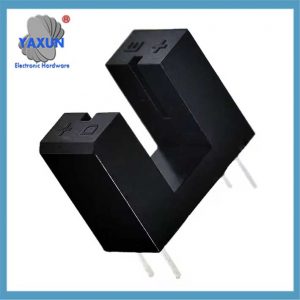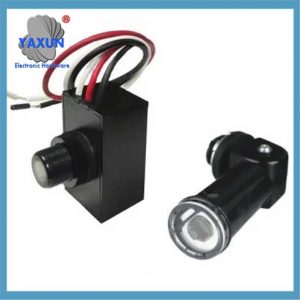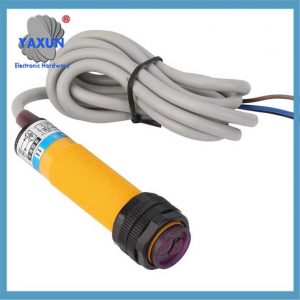MGK series photoelectric switch is the product of the development of modern microelectronics technology, and it is an upgraded product of HGK series infrared photoelectric switch. Compared with the previous photoelectric switch, it has its own remarkable features:
It has a self-diagnostic and stable working area indication function, which can promptly inform whether the working state is reliable;
Opposite-beam, reflective, and mirror-reflective photoelectric switches all have the function of preventing mutual interference and are easy to install;
 Direkter photoelektrischer Sensor über den Photoelektrikschalter Photoelektrikum zum Strahlfotoelektrikumsensor |
 Photoelectric Switch, 120-277V Dusk to Dawn Sensor Photoelectric Switch Light Photocell Sensor Lighting Switch |
 Photoelectric Switch, DC6-36V E3F-DS30C4 NPN NO Proximity Sensor Switch 10-30cm |
A photoelectric switch, also called a photoelectric sensor, is a device that detects the presence or absence of an object by measuring changes in light intensity, typically by emitting a light beam and then detecting when that beam is interrupted or reflected by an object; key characteristics include non-contact detection, long sensing distances, high speed response, ability to detect various materials (including transparent ones), and wide application in industrial automation, material handling, and everyday devices like automatic doors and hand-wave faucets.
Key Characteristics:
Non-Contact Detection:
Photoelectric switches detect objects without physically touching them, which prevents damage to both the sensor and the target object.
Long Sensing Distance:
Depending on the type of sensor, they can detect objects at significant distances, making them suitable for large areas.
Fast Response Time:
Due to the speed of light, photoelectric switches react quickly to changes in the light beam, enabling high-speed detection.
Versatility in Material Detection:
Most photoelectric sensors can detect a wide variety of materials including metals, plastics, wood, glass, and liquids, depending on the design and operating mode.
High Resolution:
Advanced designs can achieve high resolution, allowing for precise detection of small objects or object positioning.
Immune to Electromagnetic Interference:
Photoelectric sensors are generally not affected by electromagnetic noise.
Types of Photoelectric Switches:
Through-Beam:
A transmitter and receiver are positioned opposite each other, with the object interrupting the light beam between them.
Retroreflective:
The emitted light beam is reflected back to the receiver by a reflective surface on the target object.
Diffused:
The sensor emits a light beam that is scattered off the target object and then detected by the receiver.
Applications:
Industrial Automation: Detecting parts on conveyor belts, counting items, monitoring product levels, quality control checks
Material Handling: Detecting objects in robotic systems, monitoring conveyor belt alignment
Packaging Machinery: Ensuring proper package sealing, detecting product presence
Door Automation: Automatic door opening and closing mechanisms
Traffic Control Systems: Vehicle detection for traffic lights
Security Systems: Intrusion detection systems
Medical Devices: Fluid level monitoring in medical equipment
Consumer Electronics: Hand-wave activated faucets, automatic lighting systems
Setting the ES external synchronization (external diagnosis) control terminal can pre-check whether the photoelectric switch is working normally before operation. And it can accept interrupt or detection instructions from computer or programmable controller at any time, and the appropriate combination of external diagnosis and self-diagnosis can make the photoelectric switch intelligent;
The response speed is fast, and the response speed of the high-speed photoelectric switch can reach 0.1ms. It can perform 300,000 detection operations per minute, and can detect small objects moving at high speed;
Using ASIC and advanced SMT surface mount technology, it has high reliability;
Small size (minimum 20×31×12mm), light weight, simple installation and debugging, and short circuit protection.
Technical terms for photoelectric switches
Detection distance: The detection distance of through-beam and mirror reflection photoelectric switches refers to the maximum distance that can be detected stably without effective obstructions on the optical axis. The detection distance of the reflective photoelectric switch is the maximum distance that can stably detect the standard detection object.
Hysteresis distance: The hysteresis distance refers to the difference between the action distance and the reset distance. It is expressed by the ratio of the detection distance, generally below 20% of the detection distance.
Response time: The time required from the initial effective light receiving of the light receiver to the output action is called the response time.
Reset application time: The time required from the initial effective shading of the light receiver to the output reset is called the reset application time.
Dark ON (DARK ON): that is, shading action. It means that when the speed of light entering the light receiver decreases to a certain level or is completely blocked, the output transistor will turn on and output.
Bright action (LIGHT ON), also known as light action. It means that when the light beam entering the light receiver increases to a certain amount, the output transistor is turned on and has output.
External synchronous input function: In general, all photoelectric switches with external diagnostic input function generally have external synchronous function.
That is to say, it is possible to pre-check whether the sensor detection is normal before work. In work, using this property can also accept the operation or interruption command issued by the control system at any time. If the former output is connected in series with the latter external synchronization input, functions such as an AND gate can be realized.
The use of photoelectric switch
1) Photoelectric switch applications can be used in various occasions, avoiding strong light sources. Photoelectric switches can generally work stably when the ambient brightness is high. Jedoch, avoid directing the optical axis of the sensor to strong light sources such as sunlight and incandescent lamps. When the angle between the optical axis of the sensor (light receiver) and the strong light source cannot be changed, a shading plate or a long shading tube can be installed around the sensor.
2) Prevent mutual interference of photoelectric switches. MGK series new photoelectric switches usually have the function of automatically preventing mutual interference, so there is no need to worry about mutual interference. Jedoch, when several groups of HGK series through-beam infrared photoelectric switches are installed side by side, adjacent groups and mutual interference should be prevented. The most effective way to prevent this kind of interference is to set the light emitter and light receiver crosswise, and open the group distance when there are more than 2 groups. Of course, it is also a good way to use models with different frequencies.
An effective way for HGK series reflective photoelectric switches to prevent mutual interference is to keep the distance apart. Darüber hinaus, the farther the detection distance is, the larger the interval should be, and the specific interval should be determined according to the debugging situation. Of course, models with different operating frequencies can also be used.
3) The influence of the mirror angle of the photoelectric switch: When the object to be measured is shiny or meets a smooth metal surface, the reflectivity is generally very high, which acts like a mirror. At this time, the light emitter and the detection object should be installed at an angle of 10-20°, so that the optical axis is not perpendicular to the detection object, so as to prevent misoperation.
4) Elimination of background effects of photoelectric switches:
When using reflective diffuse emitters and receivers, sometimes the photoelectric switch may not be able to detect stably because the detected object is close to the background object, the photoelectric switch or the background is smooth and other objects with high reflectivity. daher, you can use distance-limited projectors and receivers, or use methods such as keeping away from the background, removing the background, painting the background in matte black, or trying to make the background rough and dark.
5) Use of the self-diagnosis function of the photoelectric switch:
During installation or use, sometimes due to the impact of the table or the background and the use of vibration, there may be problems such as slight deviation of the optical axis, lens contamination, dust accumulation, external noise, and ambient temperature out of range. These problems may cause the photoelectric switch to deviate from the stable working area. At this time, the self-diagnostic function of the photoelectric switch can be used to make a notification through the green stable indicator light of STABLE to remind the user to adjust it in time.
 English
English العربية
العربية Български
Български Čeština
Čeština Dansk
Dansk Nederlands
Nederlands Suomi
Suomi Français
Français Deutsch
Deutsch Magyar
Magyar Italiano
Italiano 日本語
日本語 한국어
한국어 Português
Português Română
Română Русский
Русский Slovenščina
Slovenščina Español
Español Svenska
Svenska Tiếng Việt
Tiếng Việt
